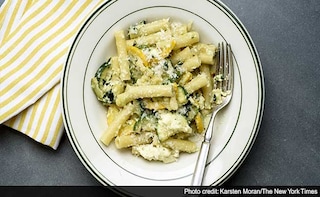A recent trip to Sicily reminded me just how marvellous fresh ricotta can be. I had the chance to visit a family-run sheep dairy to observe a cheese master at work. The farm produces pecorino cheese, both young and aged, and ricotta too, which is essentially a by-product of the cheese-making process.
It is a dish of utter simplicity, yet it tastes, to me at least, like the height of luxury.
Yield: 4 to 6 servingsExtra-virgin olive oil
1 small onion, finely diced
2 pounds zucchini, sliced into 1/4-inch thick pieces (for larger zucchini, cut in half lengthwise before slicing)
Salt and pepper
2 garlic cloves, minced, or 2 tablespoons chopped green garlic
1 ounce basil, about 2 cups loose leaves
1 pound ziti or other dry pasta
8 ounces ricotta, about 1 cup
Pinch of crushed red pepper
Zest of 1 lemon
2 ounces grated Parmesan, pecorino or a mixture, about 1 cup, plus more for serving
2. Meanwhile, use a mortar and pestle to pound garlic, basil and a little salt into a rough paste (or use a mini food processor). Stir in 3 tablespoons olive oil.
3. Salt the pasta water well and put in the pasta, stirring. Boil per package instructions but make sure to keep pasta quite al dente. Drain pasta, reserving 1 cup of cooking water.
4. Add cooked pasta to zucchini in skillet and turn heat to medium-high. Add 1/2 cup cooking water, then the ricotta, crushed red pepper and lemon zest, stirring to distribute. Check seasoning and adjust. Cook for 1 minute more. Mixture should look creamy. Add a little more pasta water if necessary. Add the basil paste and half the grated cheese and quickly stir to incorporate. Spoon pasta into warm soup plates and sprinkle with additional cheese. Serve immediately.© 2015 New York Times News Service
Advertisement
It is a dish of utter simplicity, yet it tastes, to me at least, like the height of luxury.
Advertisement
Yield: 4 to 6 servingsExtra-virgin olive oil
1 small onion, finely diced
2 pounds zucchini, sliced into 1/4-inch thick pieces (for larger zucchini, cut in half lengthwise before slicing)
Salt and pepper
2 garlic cloves, minced, or 2 tablespoons chopped green garlic
1 ounce basil, about 2 cups loose leaves
1 pound ziti or other dry pasta
8 ounces ricotta, about 1 cup
Pinch of crushed red pepper
Zest of 1 lemon
2 ounces grated Parmesan, pecorino or a mixture, about 1 cup, plus more for serving
2. Meanwhile, use a mortar and pestle to pound garlic, basil and a little salt into a rough paste (or use a mini food processor). Stir in 3 tablespoons olive oil.
3. Salt the pasta water well and put in the pasta, stirring. Boil per package instructions but make sure to keep pasta quite al dente. Drain pasta, reserving 1 cup of cooking water.
4. Add cooked pasta to zucchini in skillet and turn heat to medium-high. Add 1/2 cup cooking water, then the ricotta, crushed red pepper and lemon zest, stirring to distribute. Check seasoning and adjust. Cook for 1 minute more. Mixture should look creamy. Add a little more pasta water if necessary. Add the basil paste and half the grated cheese and quickly stir to incorporate. Spoon pasta into warm soup plates and sprinkle with additional cheese. Serve immediately.
Advertisement
For the latest food news, health tips and recipes, like us on Facebook or follow us on Twitter and YouTube.
Advertisement
